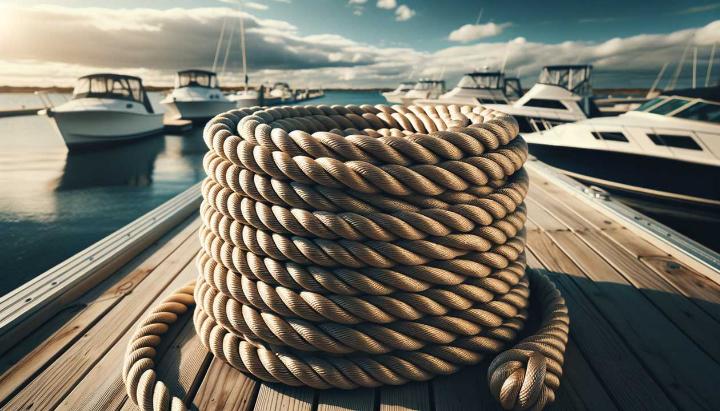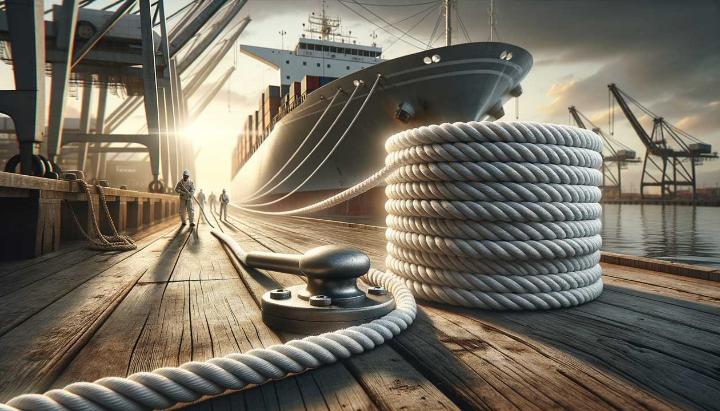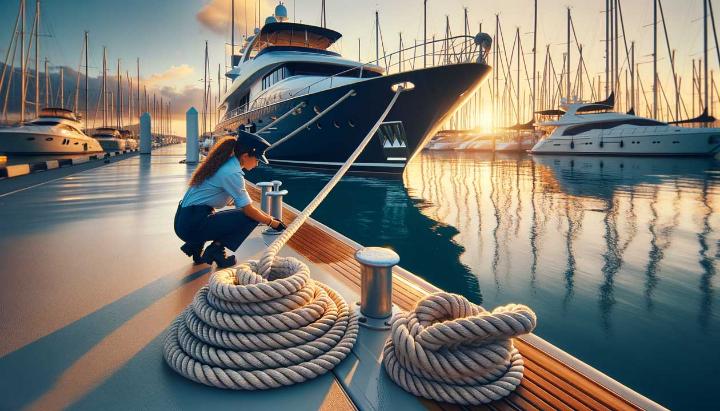Have you ever found yourself in a bind, quite literally, when it comes to choosing the right rope for your towing or docking needs? You're not alone. In the world of maritime and industrial applications, the difference between a smooth operation and a potential disaster often hinges on the type of rope you use. Today, we're diving into the fascinating world of braid rope 3 strand and 8 strand braid rope - two unsung heroes of the rope industry that boast impressive high stretch properties.
At iRopes, we've seen firsthand how the right rope can make all the difference. Whether you're securing a yacht in choppy waters or towing heavy equipment on a construction site, the strength and flexibility of your rope are paramount. That's why we're excited to explore the unique characteristics of braid rope 3 strand and 8 strand braid rope, two versatile options that excel in towing and docking applications.
In this post, we'll unravel the mysteries behind these rope structures, comparing their strengths, discussing their ideal applications, and helping you make an informed decision for your specific needs. So, grab a cuppa and join us as we discover why these high-stretch ropes are the go-to choice for professionals across industries. Trust us, by the end of this read, you'll be ready to rope in success with the perfect choice for your next project.
Understanding the Characteristics of Braid Rope 3 Strand
When it comes to choosing the right rope for your marine or industrial needs, understanding the unique characteristics of braid rope 3 strand is crucial. Let's dive into what makes this rope construction special and why it might be the perfect choice for your next project.
Construction and Materials
Braid rope 3 strand, as the name suggests, is composed of three individual strands twisted together. This classic construction method has been used for centuries, and for good reason. The materials used can vary, but commonly include nylon, polyester, or polypropylene, each offering different properties to suit specific applications.

Strength and Durability Comparison
While braid rope 3 strand may not boast the same strength-to-weight ratio as some modern synthetic ropes, it holds its own in terms of durability and versatility. Here's what sets it apart:
- High stretch properties provide excellent shock absorption, making it ideal for dynamic load applications.
- Abrasion resistance ensures longevity even in harsh environments, reducing the need for frequent replacements.
- UV stability varies depending on the material, but many 3 strand ropes offer good resistance to sun damage.
- Flexibility and ease of handling make it a favourite among sailors and industrial workers alike.
Applications and Uses
The versatility of braid rope 3 strand shines through in its wide range of applications. Have you ever wondered why it's so commonly seen on boats and docks? Here's why:
- Anchor lines
- Mooring lines
- Towing ropes
But its use isn't limited to marine environments. You'll also find braid rope 3 strand in construction, agriculture, and even recreational settings like camping or outdoor sports.
As we've explored the characteristics of braid rope 3 strand, it's clear that its high stretch properties and durability make it an excellent choice for towing and docking applications. Whether you're a seasoned sailor or a DIY enthusiast, understanding these properties can help you make an informed decision for your next rope purchase.
Advantages of 8 Strand Braid Rope
As we delve deeper into the world of ropes, it's time to explore the fascinating realm of 8 strand braid rope. This innovative design has revolutionized the rope industry, offering a plethora of benefits that set it apart from its 3 strand counterpart. Let's unravel the unique advantages that make 8 strand braid rope a game-changer for both marine and industrial applications.
Strength and Performance Benefits
When it comes to strength and performance, 8 strand braid rope truly shines. Having worked extensively with various rope types in my years as a marine engineer, I can confidently say that the difference is palpable. Here's why:
- Superior strength-to-weight ratio: 8 strand braid rope boasts an impressive strength-to-weight ratio, surpassing that of traditional 3 and 4 strand ropes. This means you get more pulling power with less weight, a crucial factor in many applications.
- Enhanced abrasion resistance: The tight braided construction provides excellent resistance to wear and tear, extending the rope's lifespan even in harsh environments.
- Increased tensile strength: The unique braiding technique distributes load evenly across all strands, resulting in higher overall tensile strength.
- No rotation under load: Unlike some other rope types, 8 strand braid rope remains stable and doesn't rotate when under tension, ensuring safer and more predictable performance.

Applications and Use Cases
The versatility of 8 strand braid rope makes it a top choice for a wide range of applications. In my experience, I've seen it excel in various scenarios:
- Marine applications: From anchoring and mooring to towing and docking, 8 strand braid rope's strength and flexibility make it ideal for numerous maritime tasks.
- Industrial uses: Its durability and high tensile strength make it perfect for heavy lifting, winching, and other industrial applications where reliability is paramount.
- Fishing industry: Commercial fishing operations benefit from its resistance to abrasion and ability to handle heavy loads, especially when used with winches and capstans.
Have you ever wondered why 8 strand braid rope is so popular among professional mariners and industrial workers alike? It's because of its unique combination of strength, flexibility, and durability. Whether you're securing a yacht in choppy waters or hoisting heavy equipment on a construction site, 8 strand braid rope provides the performance and peace of mind you need.
As we wrap up this section, it's clear that 8 strand braid rope offers significant advantages over traditional rope constructions. Its superior strength, resistance to rotation, and versatility make it an excellent choice for a wide range of applications. In the next section, we'll explore how to choose the right braid rope for your specific needs, considering factors like load capacity, stretch requirements, and more.
Choosing the Right Braid Rope for Your Needs
Selecting the perfect braid rope for your specific requirements can be a daunting task, especially with the myriad of options available. As a seasoned marine engineer, I've seen firsthand how crucial it is to choose the right rope for each unique application. Let's dive into the key factors you should consider to ensure you're making the best choice for your towing and docking needs.
Types of Braided Ropes and Their Characteristics
Before we delve into the selection process, it's essential to understand the various types of braided ropes and their unique properties. From my experience working on countless maritime projects, I've come to appreciate the nuances of each rope type:
- Cotton braided rope: Soft and comfortable to handle, ideal for decorative purposes or light-duty applications.
- Polyester braided rope: Excellent UV resistance and low stretch, perfect for outdoor use and situations requiring dimensional stability.
- Nylon braided rope: High strength and excellent shock absorption, making it a go-to choice for mooring and anchor lines.
- High Modulus Polyethylene (HMPE) rope: Incredibly strong and lightweight, often used in heavy-duty industrial applications.

Factors to Consider When Selecting Braid Rope
Now that we've covered the basics, let's explore the critical factors you need to consider when choosing the right braid rope for your needs:
- Load capacity and strength requirements: This is arguably the most crucial factor. Always choose a rope with a breaking strength significantly higher than your anticipated maximum load. For instance, when I was outfitting a large fishing trawler, we opted for an 8 strand HMPE rope due to its exceptional strength-to-weight ratio. If you're looking for guidance on heavyweight ropes, check out our insights on 1 Inch Nylon Rope's 14-Ton Break Strength for more details.
- Stretch properties: Consider the amount of elasticity you need. High-stretch ropes like nylon are excellent for absorbing shock loads, while low-stretch options like polyester maintain their length under load. For more about stretch properties, you can visit Synthetic vs Natural Fiber Ropes.
- Environmental factors: UV resistance, water absorption, and chemical resistance all play a role in rope durability. I once saw a cotton rope deteriorate rapidly on a boat left in the tropical sun - a costly lesson in choosing the right material for the environment. Learn more about choosing the best material with our guide on How to Choose the Best Black Nylon Rope.
- Rope diameter and length: These factors affect not only the rope's strength but also its handling characteristics. Ensure your chosen rope fits your equipment and provides sufficient length for your application.
Remember, the right choice often involves balancing these factors. For example, while working on a small pleasure craft, we chose a 3 strand nylon rope for its excellent shock absorption and ease of handling, despite it not being the strongest option available.
Pro tip: Always consider the specific requirements of your application. A rope that's perfect for one task may be unsuitable for another, even if they seem similar at first glance.
By carefully considering these factors and understanding the characteristics of different braid rope types, you'll be well-equipped to choose the right rope for your towing and docking needs. Remember, investing time in selecting the appropriate rope can save you from potential headaches and safety issues down the line.
Have you ever faced challenges in selecting the right rope for a specific application? Share your experiences in the comments below - I'd love to hear about them and perhaps offer some insights!
Choosing between braid rope 3 strand and 8 strand braid rope is crucial for towing and docking applications. The braid rope 3 strand offers high stretch properties for shock absorption, making it durable and flexible, while 8 strand braid rope delivers enhanced strength, increased stretch capabilities, and a smooth grip. It’s important to evaluate load capacity, stretch requirements, and rope dimensions for your specific needs. Both are excellent for various applications from maritime to industrial settings, providing reliable performance and durability.
Inquire About Our Custom Rope Solutions
Fill in the form above to learn more about our tailored rope solutions. Our experts at iRopes are ready to assist you in selecting the perfect rope to meet your towing and docking needs.